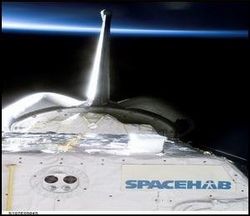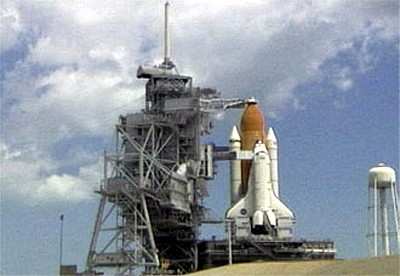Work on Second Return-to-Flight Mission Also On Target
 SPACEHAB says its STS-114 module is
a "GO" for launch on the May 2005 STS-114 space shuttle mission
with the rollout of the Company's External Stowage Platform 2 (or
ESP2). This cargo carrier marks a first in the use of large-scale
commercial hardware by NASA as it is deployed from the shuttle's
cargo bay to its permanent residence on the International Space
Station (ISS).
SPACEHAB says its STS-114 module is
a "GO" for launch on the May 2005 STS-114 space shuttle mission
with the rollout of the Company's External Stowage Platform 2 (or
ESP2). This cargo carrier marks a first in the use of large-scale
commercial hardware by NASA as it is deployed from the shuttle's
cargo bay to its permanent residence on the International Space
Station (ISS).
SPACEHAB's ESP2, a modified version of the Company's Integrated
Cargo Carrier system, will be permanently attached to the ISS
airlock and house critical replacement parts for use by the
astronaut crews. It is anticipated that the use of this
privately-developed asset on the ISS paves the way for more
commercial opportunities during ISS assembly and operations and in
support of new exploration initiatives.
"The transfer of our hardware to NASA denotes the culmination of
many testing, integration, and training activities," said E.
Michael Chewning, Senior Vice President, SPACEHAB Flight Services.
"After the successful crew equipment interface test, the STS-114
astronaut crew offered high praise for the work accomplished by our
team."

Outfitted with a host of space station 'spare parts', the ESP2
began its two-hour road trip from SPACEHAB's Payload Processing
Facility in Cape Canaveral to NASA's Kennedy Space Center where it
will be loaded into a large canister with other major hardware
elements destined for the orbiting outpost. On April 27 the entire
contents of the canister are scheduled for installation into the
Space Shuttle Discovery's cargo bay while on the launch pad,
awaiting an expected liftoff sometime between May 15 and June
3.
While all eyes are on this historic return-to-flight mission,
the SPACEHAB team is also preparing for the second space shuttle
flight, STS-121, scheduled to launch just two months after STS-114.
On this mission, SPACEHAB is providing its non-deployable
Integrated Cargo Carrier (ICC) system. The STS-121 crew has begun
hardware familiarization and training exercises on the ICC, with
more preparation scheduled later in the month at SPACEHAB's
Headquarters in Houston and at the Company's Florida facility.
The ICC provides a robust, modular, and flexible unpressurized
pallet resource, nestled in the shuttle's cargo bay, whose multiple
mission configurations can accommodate a variety of payloads. One
such SPACEHAB payload on the STS-121 mission is a large storage
chest, known as the deployable SHOSS Box, which will be transferred
and mounted to the ESP2, previously flown onboard STS-114. This box
contains spare parts for future repair and maintenance of the
ISS.
The work completed on these missions is opening doors to new
SPACEHAB opportunities. For example, the Company is finalizing
plans to provide another stowage platform, ESP3, which would be
flown on STS-118 and also mounted to the ISS. This cargo carrying
pallet, flown in conjunction with SPACEHAB's Single Logistics
Module, is currently scheduled for launch in July 2006.

"Our hardware flexibility and expert team are ready to meet
evolving requirements as NASA works to complete ISS assembly and
begin on-orbit operations," said Michael E. Kearney, SPACEHAB
President and Chief Executive Officer. "We look forward to
supporting NASA on ISS assembly completion efforts."
 ANN's Daily Aero-Linx (05.06.25)
ANN's Daily Aero-Linx (05.06.25) ANN's Daily Aero-Term (05.06.25): Ultrahigh Frequency (UHF)
ANN's Daily Aero-Term (05.06.25): Ultrahigh Frequency (UHF) ANN FAQ: Q&A 101
ANN FAQ: Q&A 101 Classic Aero-TV: Virtual Reality Painting--PPG Leverages Technology for Training
Classic Aero-TV: Virtual Reality Painting--PPG Leverages Technology for Training Airborne 05.02.25: Joby Crewed Milestone, Diamond Club, Canadian Pilot Insurance
Airborne 05.02.25: Joby Crewed Milestone, Diamond Club, Canadian Pilot Insurance





